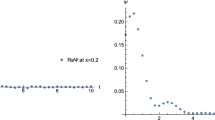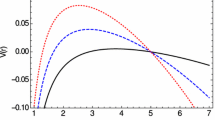Abstract
We calculate numerically the quasinormal frequencies of the Klein-Gordon and Dirac fields moving in the two-dimensional dimensionally reduced BTZ black hole. Our work extends results previously published on the damped oscillations of this black hole. First, we compute the quasinormal frequencies of the minimally coupled Klein-Gordon field for a range of the dimensionally reduced BTZ black hole physical parameters that is not previously analyzed. Furthermore we determine, for the first time, the quasinormal frequencies of the Dirac field propagating in the dimensionally reduced BTZ black hole. For the Dirac field we use the Horowitz-Hubeny method and the asymptotic iteration method, while for the Klein-Gordon field the extension of the previous results is based on the asymptotic iteration method. Finally we discuss our main results.











Similar content being viewed by others
Notes
In Ref. [22] are studied the same 2D black holes that in this paper, but the Jackiw-Teitelboim black hole is called “uncharged Achucarro-Ortiz black hole”, whereas the dimensionally reduced BTZ black hole is called “charged Achucarro-Ortiz black hole”. Since the last name is similar to one previously used to denote a three-dimensional black hole related to the BTZ solution (see for example [30] and references cited therein), in this paper, to avoid confusion, we do not employ the names given to these 2D black holes in Ref. [22].
We point out that in this work the radii of the horizons must always fulfill \(r_+ > r_-\).
References
Kokkotas, K.D., Schmidt, B.G.: Living Rev. Rel. 2, 2 (1999). [arXiv:gr-qc/9909058]
Konoplya, R., Zhidenko, A.: Rev. Mod. Phys. 83, 793 (2011). [arXiv:1102.4014 [gr-qc]]
Berti, E., Cardoso, V., Starinets, A.O.: Class. Quant. Grav. 26, 163001 (2009). [arXiv:0905.2975 [gr-qc]]
Chan, J., Mann, R.B.: Phys. Rev. D 55, 7546 (1997). [arXiv:gr-qc/9612026 [gr-qc]]
Chan, J.S.F., Mann, R.B.: Phys. Rev. D 59, 064025 (1999)
Horowitz, G.T., Hubeny, V.E.: Phys. Rev. D 62, 024027 (2000). [hep-th/9909056]
Avis, S.J., Isham, C.J., Storey, D.: Phys. Rev. D 18, 3565 (1978)
Breitenlohner, P., Freedman, D.Z.: Phys. Lett. B 115, 197–201 (1982)
Burgess, C.P., Lutken, C.A.: Phys. Lett. B 153, 137–141 (1985)
Birmingham, D., Sachs, I., Solodukhin, S.N.: Phys. Rev. Lett. 88, 151301 (2002). [arXiv:hep-th/0112055]
Grumiller, D., Kummer, W., Vassilevich, D.V.: Phys. Rept. 369, 327 (2002). [hep-th/0204253]
Grumiller, D., Meyer, R.: Turk. J. Phys. 30, 349 (2006). [hep-th/0604049]
Becar, R., Lepe, S., Saavedra, J.: Phys. Rev. D 75, 084021 (2007). [arXiv:gr-qc/0701099]
Lopez-Ortega, A.: Int. J. Mod. Phys. D 18, 1441 (2009). [arXiv:0905.0073 [gr-qc]]
Myung, Y.S., Moon, T.: Phys. Rev. D 86, 024006 (2012). [arXiv:1204.2116 [hep-th]]
Becar, R., Lepe, S., Saavedra, J.: Int. J. Mod. Phys. A 25, 1713 (2010)
Kettner, J., Kunstatter, G., Medved, A.J.M.: Class. Quant. Grav. 21, 5317 (2004). ([gr-qc/0408042])
Lopez-Ortega, A.: Int. J. Mod. Phys. D 20, 2525 (2011). [arXiv:1112.6211 [gr-qc]]
Li, X.Z., Hao, J.G., Liu, D.J.: Phys. Lett. B 507, 312 (2001). ([gr-qc/0205007])
Estrada-Jiménez, S., Gómez-Díaz, J.R., López-Ortega, A.: Gen. Relativ. Gravit 45, 2239 (2013). [arXiv:1308.5943 [gr-qc]]
Stetsko, M.M.: Eur. Phys. J. C 77, 416 (2017). [arXiv:1612.09172 [hep-th]]
Cordero, R., Lopez-Ortega, A., Vega-Acevedo, I.: Gen. Relativ. Gravit 44, 917 (2012). [arXiv:1201.3605 [gr-qc]]
Lopez-Ortega, A., Vega-Acevedo, I.: Gen. Relativ. Gravit 43, 2631 (2011). [arXiv:1105.2802 [gr-qc]]
Bhattacharjee, S., Sarkar, S., Bhattacharyya, A.: Phys. Rev. D 103(2), 024008 (2021). [arXiv:2011.08179 [gr-qc]]
Cadoni, M., Oi, M., Sanna, A.P.: JHEP 01, 087 (2022). [arXiv:2111.07763 [gr-qc]]
Hernandez-Velazquez, M.I., Lopez-Ortega, A.: Front. Astron. Space Sci. 8, 713422 (2021). [arXiv:2108.09559 [gr-qc]]
Zelnikov, A.: JHEP 0807, 010 (2008). [arXiv:0805.4031 [hep-th]]
Achucarro, A., Ortiz, M.E.: Phys. Rev. D 48, 3600–3605 (1993). [arXiv:hep-th/9304068 [hep-th]]
Cardoso, V., Lemos, J.P.S.: Phys. Rev. D 63, 124015 (2001). [arXiv:gr-qc/0101052 [gr-qc]]
Pourhassan, B., Övgün, A., Sakallı, İ: Int. J. Geom. Meth. Mod. Phys. 17(10), 2050156 (2020). [arXiv:1811.02193 [gr-qc]]
Ciftci, H., Hall, R.L., Saad, N.: J. of Phys. A Math. Gen. 36, 11807 (2003)
Cho, H., Cornell, A., Doukas, J., Naylor, W.: Class. Quant. Grav. 27, 155004 (2010). [arXiv:0912.2740 [gr-qc]]
Cho, H., Cornell, A., Doukas, J., Huang, T., Naylor, W.: Adv. Math. Phys. 2012, 281705 (2012). [arXiv:1111.5024 [gr-qc]]
Parker, L.E., Toms, D.J.: Quantum Field Theory in Curved Spacetime. Cambridge University Press, United Kingdom (2009)
Hod, S.: Phys. Rev. Lett. 81, 4293 (1998). [arXiv:gr-qc/9812002 [gr-qc]]
Maggiore, M.: Phys. Rev. Lett. 100, 141301 (2008). [arXiv:0711.3145 [gr-qc]]
Acknowledgements
This work was supported by CONACYT México, SNI México, EDI IPN, COFAA IPN, and Research Project IPN SIP 20221379.
Author information
Authors and Affiliations
Corresponding author
Ethics declarations
Data Availability Statement
The original contributions presented in the study are included in the article, further inquiries can be directed to the corresponding author.
Additional information
Publisher's Note
Springer Nature remains neutral with regard to jurisdictional claims in published maps and institutional affiliations.
Appendices
Appendix A Asymptotic iteration method
An useful method to find the eigenvalues of linear second order differential equations is the asymptotic iteration method [31,32,33]. This method works with linear second order differential equations of the form
where the prime denotes differentiation with respect to the independent variable. Taking advantage of the symmetrical structure of Eq. (A1) we find that its first derivative takes a similar mathematical form
with
In an analogous way we find that the \((n+2)\)-th derivative of the function y is equal to [31,32,33]
where
The asymptotic aspect of the method imposes that for sufficiently large n the functions \(\lambda _n\) and \(s_n\) satisfy [31,32,33]
or in an equivalent form
Solving this equation, usually known as discretization condition, we can find the QNFs of the black hole under study [32, 33].
Nevertheless, the computation of the recurrence relations (A5) requires many resources [31,32,33]. Owing this fact, in Ref. [32] is proposed an improved version of the AIM. In this version of the method we expand the functions \(\lambda _n\) and \(s_n\) around a convenient point \(\xi \), that is,
to find that the recurrence relations (A5) imply that the coefficients \(c^i _n\) and \(d^i _n\) satisfy
Furthermore, we get that the discretization condition (A7) takes the form
Solving this equation for different values of n, we numerically obtain the QNFs of the studied black hole [32, 33]. In this work we use this improved formulation of the AIM to find the QNFs of the Klein-Gordon and Dirac fields propagating in the DRBTZ black hole.
Appendix B Horowitz-Hubeny method for the Dirac field
For the Klein-Gordon field moving in the DRBTZ black hole, in Ref. [22] are calculated its QNFs taking as a basis the Horowitz-Hubeny method. Nevertheless a restriction on the values of the horizons radii was imposed, as we previously commented. For the Dirac field we can use the Horowitz-Hubeny method to compute its QNFs in the DRBTZ black hole. In what follows we describe the steps to transform the radial Eqs. (31) into a convenient form to use the Horowitz-Hubeny method [6].
First, to fulfill the boundary condition near the event horizon, we propose that the solutions of Eqs. (31) take the form
to find that the functions \(U_s\) must satisfy the differential equations
To have an independent variable that changes in a finite interval, following to Horowitz-Hubeny [6], we make the change of variable
to get that the radial Eqs. (B12) transform into
where the functions \(t_s(x)\), \(u_s(x)\), and \(S_s(x)\) are equal to
In the previous equations we define \(x_+= 1/r_+\) and \(x_-=1/r_-\).
As in Ref. [6] we propose that the solutions to Eqs. (B14) take the form
but to fulfill the boundary condition of the QNMs near the event horizon we must take \(\nu _s=0\) [6]. Substituting these simplified forms of the functions \(U_s\) into Eq. (B14), we find that the coefficients \(a_{k,s}\) must satisfy the recurrence relations
where \( S_{0,s}= S_s (x_+)\), \( t_{0,s} = t_s(x_+)\), the coefficients \(u_{k,s}\) are given by
and similar definitions are valid for the coefficients \(S_{k,s}\) and \(t_{k,s}\).
At the asymptotic region, the boundary condition of the QNMs imposes that as \(x \rightarrow 0\) (\(r \rightarrow \infty \)) the functions \(U_s\) go to zero, that is,
and the QNFs of the Dirac field can be calculated by finding the roots of the previous equation when we replace the infinite sum by a finite sum [6].
As for the Klein-Gordon field moving in the DRBTZ black hole, the Horowitz-Hubeny method allows us to calculate the QNFs of the Dirac field when \(r_+ > 2r_-\). The reason is that the series (B16) has a radius of convergence as large as the distance to the nearest singular point. Since the radius of convergence must include the point \(x=0\), the distance from the expansion point at \(x_+\) to the other singularity at \(x_-\) must be larger than the distance between \(x_+\) and 0, that is, \(x_--x_+ > x_+\), or equivalently \(r_+ > 2r_-\).
Rights and permissions
About this article
Cite this article
Gutiérrez-Dávila, K.A., López-Ortega, A. Quasinormal frequencies of the dimensionally reduced BTZ black hole. Gen Relativ Gravit 54, 73 (2022). https://doi.org/10.1007/s10714-022-02959-8
Received:
Accepted:
Published:
DOI: https://doi.org/10.1007/s10714-022-02959-8




